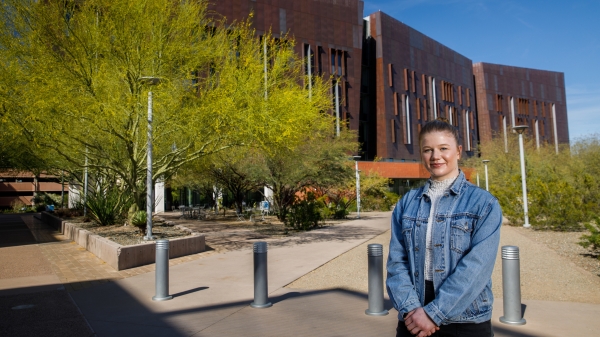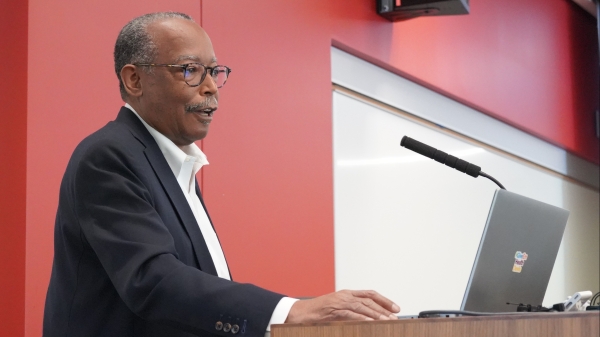Global alliance forms to find effective response to deadliest brain tumor
GBM AGILE to implement unprecedented international clinical trial

This year, tens of thousands of people around the globe — including about 12,000 in the U.S. and 35,000 in China alone — will be diagnosed with glioblastoma multiforme (GBM), the most common adult brain tumor. GBM is highly aggressive: 50 percent of patients survive for a year or less, and the five-year survival is less than 2 percent, and these dismal statistics have not changed for decades.
A broad coalition of GBM neurosurgeons, neuro-oncologists, basic and clinical investigators and representatives from the GBM advocacy communities shared the conviction that this situation was unacceptable, that new approaches must be pursued that can identify successful therapies.
“It is in that spirit, that this broad ‘coalition of the willing’ today announce the design and plan for a new-generation clinical trial for GBM,” said Dr. Anna Barker, GBM AGILE (Adaptive, Global, Innovative Learning Environment) project director and Executive Committee (EC) chair, director of the National Biomarker Development Alliance (NBDA) and professor at Arizona State University’s School of Life Sciences.
Video: Olivia Newton-John, who lost her sister to GBM, shares why she is supporting the alliance.
“This new generation of clinical trials will be adaptive based on learning from the patients; global as it is to be performed across the U.S., China, Australia and Europe; and innovative in that it is driven by Bayesian statistics and molecular markers. The nature of this trial is that it will be a ‘learning environment’ that allows the response of each patient to inform the ongoing conduct of the trial,” said Dr. Web Cavenee, GBM AGILE co-investigator; EC member; and director, Strategic Alliances CNS, Ludwig Institute for Cancer Research and University of California San Diego.
Hundreds of clinical trials have tested numerous therapies for GBM, but treatment options and patient outcomes have not changed for several decades. Notably, the single advance in the treatment of GBM occurred more than a decade ago when a drug called temozolomide was tested with radiation therapy in a Phase 3 trial and reported to extend life by about two months. In addition to the dismal record of clinical trials for GBM, there are virtually no biomarkers that can be employed to drive drug development and guide treatment. As a result, GBM patients have not benefited from the advances known as “precision medicine.”
“We have to do something more — something different — something that brings the best science and innovative clinical trials together to identify therapies that work,” said Dr. Mitchell Berger, GBM AGILE co-investigator; EC member; and chief of neurosurgery at the University of California San Francisco. “GBM AGILE is the best path to achieve those goals than I have seen for decades.”
“Since GBM AGILE will be performed on a global basis,” said Dr. Mustafa Khasraw, GBM AGILE EC Australian liaison and medical oncologist, University of Sydney, “we will finally be able to benefit from the convergence of the basic and clinical research that is driving our progress in neuro-oncology in Australia and across the globe. Moreover, this collaboration will enable recruiting sufficient numbers of patients to learn through the adaptive trial which therapies do or do not work for GBM. Australia is actively involved in the planning and design of GBM AGILE, and we are excited to be able to contribute to its implementation.”
This “perfect storm” of factors led the GBM AGILE Global team to reach beyond classic clinical trials strategies to create a potentially paradigm-shifting “next-generation platform adaptive trial” for GBM.
“GBM AGILE will employ advanced statistical tools to ensure that better treatments can be assigned to more patients and ineffective treatments can be eliminated from the trial,” said Dr. Donald Berry, GBM AGILE co-principal investigator, EC member and professor of biostatistics at the University of Texas MD Anderson Cancer Center.
GBM AGILE will be performed using a “master protocol.” This innovative approach, developed by the U.S. Food and Drug Administration, will enable centralizing a number of functions for the trial and simplify the efforts needed to add new therapies to the ongoing trial process. Molecular biomarkers will be employed to assign specific patients to matching therapies (arms) of the trial. As observed in other types of cancers, GBM patients are likely to benefit most by receiving therapies that may be effective only in subsets of patients with a specific molecular alteration. This molecularly targeted approach is the basis for “precision medicine.”
“Thanks to the deep molecular characterization of GBM, we are beginning to get a better picture of the genes and pathways that are altered in GBM, so there is finally an opportunity to identify real biomarkers and conduct a ‘smart’ trial like GBM AGILE,” said Dr. Alfred Yung, GBM AGILE EC member; chairman and professor, Department of Neuro-Oncology; Margaret and Ben Love Chair in Clinical Cancer Care, MD Anderson.
During the planning and design phase, GBM AGILE is “crowdsourcing” knowledge from a large number of international leaders in GBM basic and clinical research and using that knowledge to inform the design of a new-generation adaptive trial that will learn from every patient who enters the trial.
“The Chinese neurosurgery communities look forward to implementing GBM AGILE in China and to working with the GBM Global team,” said Dr. Tao Jiang, GBM AGILE EC China liaison, vice director of Beijing Neurosurgical Institute and director and founder of Chinese Glioma Genome Atlas (CGGA). “We finally have the opportunity to work together across borders to learn from every patient and identify better therapies for GBM patients no matter where they are on the globe.”
“As a neuro-oncologist taking care of GBM patients every day, GBM AGILE is groundbreaking in so many ways,” said Dr. Timothy Cloughesy, GBM AGILE principal investigator; EC member; and director, UCLA Neuro-Oncology Program. “The adaptive design will allow us to modify the trial as it proceeds based on the data collected — and to test many drugs and combinations versus single agents — and to do it faster. It’s an opportunity for patients to benefit from precision medicine, and a real source of hope for patients and their families.”
The work to design and implement GBM AGILE is well underway. More than 100 neurosurgeons, neuro-oncologists, pathologists, imagers, neuroscientists and patient advocates make up 10 major committees that donate their time and pay their own travel costs to participate in planning and designing GBM AGILE. Despite time-zone differences, the groups meet regularly by phone (and in person) to tackle the challenges related to everything from selecting drugs and biomarkers for the trial to design issues and numerous other challenges. A number of GBM patient-advocacy groups have joined the GBM AGILE team, including the U.S.-based National Brain Tumor Society, Accelerate Brain Cancer Cure, National Foundation for Cancer Research and the Australian Cure Brain Cancer Foundation.
“I know I speak for all of the patient-advocacy groups when I say that the commitment we have seen from the international GBM research communities to unite different disciplines and break down barriers for the benefit of GBM patients is inspiring to all of us,” said Dr. Sujuan Ba, GBM AGILE EC member and president of the National Foundation for Cancer Research.
The GBM AGILE global team has two ambitious goals: to begin enrolling patients by mid-2016; and even more audacious, to raise funds for GBM AGILE from philanthropists, research foundations and crowd funding. Several organizations are supporting the planning and design phase for GBM AGILE, including the National Biomarker Development Alliance (Arizona State University), Cure Brain Cancer Foundation, National Foundation for Cancer Research, ASU Foundation and the GBM AGILE global team.
“None of us are willing to continue to tolerate the tragic and costly loss of life inflicted on patients who are stricken with GBM,” Barker said. “GBM AGILE is truly a ‘global coalition,’ and it’s always humbling to see the power of a group this committed to changing the world.”
Watch the GBM AGILE announcement live from the National Press Club in Washington, D.C., at noon (Arizona time) Thursday: http://nbdabiomarkers.org/gbm-agile.
GBM AGILE is being developed through the National Biomarker Development Alliance (NBDA), a non-profit organization created as part of the Research Collaboratory at Arizona State University. The NBDA’s mission is to collaboratively create standards-based, end-to-end systems solutions for biomarker discovery, development and delivery to advance precision medicine. The NBDA operates through trans-disciplinary and trans-sector networks to develop new research networks and consortia that focus on “demonstration projects” that advance all aspects of biomarker research and applications — especially developing smarter and more efficient clinical trials. Although NBDA is generally disease agnostic, rare diseases like GBM are a focus for the alliance since in most cases few if any biomarkers exist and most clinical trials fail. Overall, the NBDA is dedicated to moving high-quality, effective biomarkers through all phases of discovery, development and validation through more innovative and efficient clinical trials to ensure that the promise of precision (molecularly based) medicine will be available to all patients.
Written by Anna D. Barker, ASU.
More Health and medicine

First exchange student for Biodesign Institute Europe bridges labs 5,000 miles apart
This spring semester, Grace Colley traveled to Arizona State University and became the first student to participate in the Biodesign Institute Europe student exchange program. In doing so, she helped…

College of Health Solutions hosts visit from leading expert in genomic research
Some fortunate Arizona State University faculty, staff and students were able to gain valuable insights and perspective during a visit by one of the country’s leading figures in health and scientific…

Indigenous ASU research team recommends assistance for tribal members still reeling from COVID-19’s effects
When Matt Ignacio’s tribe, the Tohono O’odham Nation, donated $1 million to Arizona State University to support COVID-19 research, he applied for some of the money to understand and report any…